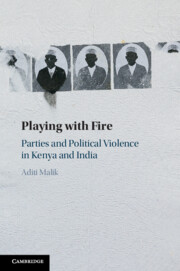Book contents
- Playing with Fire
- Playing with Fire
- Copyright page
- Dedication
- Contents
- Figures
- Tables
- Acknowledgments
- Abbreviations
- 1 Parties and Political Violence
- 2 A Theory of Party Instability and Political Violence
- 3 The Development of Divergent Parties and Party Systems in Kenya and India
- 4 Party Instability and Political Violence in Kenya
- 5 Party Fragility and Subnational Patterns of Violence in Kenya’s Rift Valley and Coast Regions
- 6 Party Stabilization, Declining Riot Violence, and New Modalities of Political Conflict in India
- 7 Party Politics and Subnational Trajectories of Riot Violence in India’s Hyderabad and Meerut Cities
- 8 Party Instability and Political Violence
- 9 Conclusion
- Book part
- References
- Datasets
- Index
3 - The Development of Divergent Parties and Party Systems in Kenya and India
Published online by Cambridge University Press: 25 October 2024
- Playing with Fire
- Playing with Fire
- Copyright page
- Dedication
- Contents
- Figures
- Tables
- Acknowledgments
- Abbreviations
- 1 Parties and Political Violence
- 2 A Theory of Party Instability and Political Violence
- 3 The Development of Divergent Parties and Party Systems in Kenya and India
- 4 Party Instability and Political Violence in Kenya
- 5 Party Fragility and Subnational Patterns of Violence in Kenya’s Rift Valley and Coast Regions
- 6 Party Stabilization, Declining Riot Violence, and New Modalities of Political Conflict in India
- 7 Party Politics and Subnational Trajectories of Riot Violence in India’s Hyderabad and Meerut Cities
- 8 Party Instability and Political Violence
- 9 Conclusion
- Book part
- References
- Datasets
- Index
Summary
This chapter traces political party development in Kenya and India from a comparative and historical perspective. It shows that despite many shared experiences as British colonies, nationalist parties with transoceanic connections to one another, and dominant party structures that endured for several years after independence, party development in the two countries took very different routes in the medium and long terms. In Kenya, the Kenya African National Union (KANU) emerged as a narrow, divisive, and ethnically oriented party. By contrast, the Indian National Congress (INC) developed deep societal roots, penetrated rural areas, and sought to unite Indians across caste and ethnic divides. These divergent trajectories influenced the development of new party entrants and generated differing incentive structures for instrumentalizing party violence in the two countries.
Keywords
- Type
- Chapter
- Information
- Playing with FireParties and Political Violence in Kenya and India, pp. 51 - 75Publisher: Cambridge University PressPrint publication year: 2024

